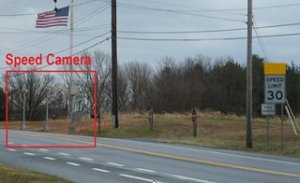On January 13, the Fairfax city council will adopt a contract with Redflex Traffic Systems to install deadly red light cameras at ten intersections in Fairfax, Virginia. How does this work?
Redflex, a company based in Melbourne, Australia, promises to pay the city of Fairfax for the privilege of installing the cameras, reviewing the photographs, creating public relations material promoting the system (i.e. propaganda), repairing any damage, preparing all materials for court hearings, mailing citations and collecting fine payments. It’s all spelled out in Appendix B of the contract (warning: PDF) You might be wondering, if Redflex is doing so much then what role does the city have? The answer is: none. In fact, Fairfax doesn’t even need to go down to the bank and cash its giant monthly check.
Redflex will deposit all of the ticket revenue in the city’s bank account — minus a monthly fee of $4,740 per intersection or a grand total of $568,800 per year. In fact, Redflex guarantees that the city will not, under any circumstances, lose any money on the deal, even if no tickets are ever issued. This so-called “cost neutrality” provision, spelled out in Appendix D, also happens to be illegal.
The contract says:
Cost Neutrality
Cost neutrality is assured to Customer — Customer will never be required to pay Redflex more than actual cash received by Redflex, and such cost neutrality should be reconciled on a monthly basis. This is a material provision of this Agreement and a condition precedent for Customer agreeing to enter into this Agreement.
In other words, despite all the wonderful benefits promised, the city has no interest in paying for its “safety” program. The most important provision in the entire document, the “condition precedent,” is that the city of Fairfax make a profit. We’ll let the reader decide whether that’s a shady motivation or not. Let’s look instead at what the Code of Virginia has to say about it.
A private entity may enter into an agreement with a locality to be compensated for providing the traffic light signal violation monitoring system or equipment, and all related support services, to include consulting, operations and administration…. No locality shall enter into an agreement for compensation based on the number of violations or monetary penalties imposed.
So, let’s think about this. Redflex must be able to keep $4,740 per intersection per month from the cash it collects from motorists. That’s roughly a total of 95 paid tickets. What happens if only half that amount, say 45 tickets, are actually paid? That would mean that Redflex would collect $2,250, but Fairfax would not be required to make up the difference because the contract says: “Customer will never be required to pay Redflex more than actual cash received by Redflex.”
That means if Redflex collects $2,250 in monetary payments, the company — a private entity — will be compensated $2,250. If Redflex collects on one more ticket to $2,300, then Redflex will be compensated $2,300. And so on up to $4,740. There is no getting around the fact that this would be compensation according to the number of violations and the amount of monetary penalties imposed.
An appellate court in California has already considered this issue and struck down a similar contract between the city of Fullerton and a different firm, Nestor Traffic Systems (NTS). The judge ruled:
The possibility that fees could be negotiated ‘down’ if it is determined fees paid to NTS exceed ‘net program revenues being realized,’ indirectly ties fees to NTS to the amount of revenue generated from the program. If insufficient revenue is generated to cover the monthly fee, the fee could be ‘negotiated down.’ As such, NTS has an incentive to ensure sufficient revenues are generated to cover the monthly fee.
So, not only is what Fairfax City proposes to do dangerous, it’s also illegal.



 Posted by capitalfraud
Posted by capitalfraud 